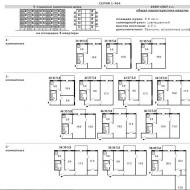
The greater the risk, the greater the income. Risk factors: what determines the return on investment in real estate. reaching a certain level of profitability
When investing funds. A low level of uncertainty (low level of risk) is accompanied by low potential returns, while a high level of uncertainty (high level of risk) is usually associated with high potential returns. In accordance with the economic category "risk-return", the invested funds can provide a higher return only if they have a higher level of risk of their partial or complete loss.
The most general patterns reflecting the relationship between the assumed risk and the expected return on the investor's activities are as follows:
- more risky investments, as a rule, are characterized by higher returns;
- with an increase in income, the probability of its receipt decreases, while a certain minimum guaranteed income can be obtained with practically no risk.
The optimality of the ratio of income and risk means reaching a maximum for a combination of "return-risk" or a minimum for a combination of "risk-return". In this case, two conditions must be met simultaneously:
- no other ratio of return and risk can provide a higher return for a given or lower level of risk;
- no other ratio of return and risk can provide less risk for a given or greater level of return.
The figure shows that assuming one risk and one source of income is accepted, there is only one such combination - point E.
However, since in practice investment activity is associated with multiple risks and the use of various resource sources, the number of optimal ratios increases. In this regard, in order to achieve a balance between risk and return, it is necessary to use a step-by-step method of solving by successive approximations. Exercise involves not only taking a certain risk, but also securing a certain income. If we assume that the minimum required income corresponds to the minimum risk, then several sectors can be distinguished, characterized by a certain combination of income and risk: A, B, C.
Sector A, investments in which do not provide the minimum required income, can be considered as an area of insufficient profitability. Operations in sector C are associated with high risks that reduce the possibility of receiving the expected high returns, therefore, sector C can be identified as an area of high risk. Making investments in sector B provides the investor with income at acceptable risk, therefore, sector B is the area of optimal values of the ratio of return and risk.
All investment products can be conditionally divided into classes based on their risk.
The first class is debt financial instruments. It includes government, corporate and banking products:,. The yield on debt instruments is determined by two components: the probability of the borrower and the maturity.
Traditionally, it is believed that the most reliable -. Moreover, short-term US Treasury bonds - the so-called T-bills, which are issued in the form of promissory notes with a maturity of up to one year, are taken as the basic level of yield. Their profitability is close to zero. This does not mean that these securities do not carry risks - they are just the starting point of today's global financial system. In addition, the Treasury issues medium-term T-notes for 1 to 10 years and long-term T-bonds for over 10 years.
Government securities of other countries offer investors greater returns. This is due to the fact that they carry a high probability of government default, as well as in relation to today's basic world currency - the US dollar.
The next group of financial instruments in this class is bank deposits. Reliability on them is higher than on securities of corporate borrowers, as a result of banking activities, which reduces the likelihood of default. To some extent, this is ensured by state guarantees of deposits.
Corporate securities offer even greater returns because they have their own risk of business problems plus the risk of the state in which the company is located and the bank serving this organization.
Securities of the same class may have different yields. For example, bills are paid more than bonds. This is due to the risk of counterfeiting and loss of bearer paper.
The second class of securities is equity, that is. Payments on them are not guaranteed. Therefore, investors demand for this even greater profitability, which consists of plus the potential growth in market value.
The third class of securities is. Profitability on them is not guaranteed. Moreover, for example, they carry an unlimited risk of loss for investors. It is permissible to assert that trading in derivative securities is not a transaction with the assets themselves, but with the risks associated with the prices of these assets and the corresponding insurance premiums. That is why such products are offered only to those who know how to correlate the expected profitability with possible losses.
Comparison of the yield on different instruments, subject to comparable maturities, makes it possible to assess how much one of these securities is more risky than the other.
The main criteria for the investment qualities of investment objects are profitability, risk and liquidity.
The profitability of financial instruments is determined by the profit, the growth of the market value in comparison with the invested funds.
Risk when investing in financial instruments means the possibility of a shortfall in income or loss of invested funds, profitability and risk are in direct relationship. The liquidity of financial instruments acts as their ability to quickly and without loss turn into money.
In the financial market, each instrument is analyzed, primarily from the point of view of these qualities.
Let us give, for example, in Table 8.1 a comparative characteristic of some securities in terms of risk and return indicators.
| Type of security | Advantages | disadvantages |
| Ordinary shares | Opportunity to receive high dividends during the period of effective activity. High liquidity. Possibility to influence the growth of profitability and reduce risks by participating in the management and policy development of the firm | Non-guaranteed and predictable nature of income. High risk associated with opportunity non-payment of dividends, loss of capital in the event of bankruptcy or liquidation of the company. The last priority is the return of capital in the liquidation of the company. The inability for small shareholders to influence the policy of the firm |
| Privileged | A stable level of income in the form of receiving dividends of a predetermined amount, regardless of the results of economic activities. Possibility of liquidity through pre-emptive right to buy back shares. Low risk due to pre-emptive right to receive dividends and share | During the period of effective activity, dividends may be lower than on ordinary shares. Lower liquidity in the stock market. The possibility of buyback is beyond the wishes of the shareholder. Limiting the possibility of influencing the management of the company |
| continued on next page | ||
Table 8.1 - Comparative characteristics of the investment qualities of some types of securities
| Type of security | Advantages | disadvantages |
| property upon liquidation of the company | ||
| Mortgages bonds | Stable income level. High liquidity. Low level of risk due to reliable guarantee of debt repayment and priority right to return the invested funds upon liquidation of a company | Lower income level than other types of bonds. Lack of the right to participate in the management of the company |
| The mortal bonds | Stable income level. Higher interest rate compared to mortgage bonds | High level of risk due to lack of reliable collateral and the right of presentation property claims against the company in case of non-payment of debt. Lack of the right to participate in management |
| Convertible bonds | Stable income level. Low level of risk due to the conditional right to exchange for shares and other securities, the primary right to return on investment in case of liquidation of the company | Lower yield than other types of bonds. Lack of the right to participate in the management of the company |
The risk-return tradeoff is the most important concept for any investor, which states that the return is directly proportional to the risk.
The relationship between profitability and risk is shown in Figure 8.1.
In this chart, the abscissa is measured in root mean square (standard) deviation, which measures the instrument's volatility over time. It is the variability that is the main manifestation of risk.
The most general patterns reflecting the relationship between the assumed risk and the expected return on the investor's activities are as follows:
More risky investments, as a rule, are characterized by higher returns;
Rice. 8.1 - Risk-reward ratio
As income grows, the likelihood of earning it decreases, while a certain minimum guaranteed income can be obtained with little or no risk.
The optimality of the ratio of income and risk means reaching a maximum for the combination "return - risk" or a minimum for a combination of "risk - return". In this case, two conditions must be met simultaneously:
No other ratio of return and risk can provide more return for a given or less level of risk;
No other ratio of return and risk can provide less risk for a given or greater level of return.
However, since in practice investment activity is associated with multiple risks and the use of various resource sources, the number of optimal ratios increases. In this regard, in order to achieve a balance between risk and return, it is necessary to use a step-by-step method of solving by successive approximations. Implementation of investment activities involves not only taking a certain risk, but also providing a certain income. If we assume that the minimum required income corresponds to the minimum risk, then several sectors can be distinguished, characterized by a certain combination of income and risk: A, B, C.
Sector A, investments in which do not provide the minimum required income, can be considered as an area of insufficient profitability. Operations in sector C are associated with high risks that reduce the possibility of receiving the expected high returns, therefore, sector C can be identified as an area of high risk. Making investments in sector B provides the investor with income at acceptable risk, therefore, sector B is the area of optimal values of the ratio of return and risk.
There are several things to consider when assessing risk. First, there is such a concept as a risk-free rate or profit, which describes the profitability that can be obtained in a particular economy.
cheat without risk. The risk-free rate is the smallest possible predictable rate of return. But precisely because it is predictable, it is low.
A measure of this risk-free rate of return is the government bond rate. Since the likelihood of a government default is very small, you can count on a return on investment with little or no risk, but getting back only a minimal profit.
But as a rule, investment activity involves obtaining a greater profit than inflationary processes. And the returns on risk-free instruments do not exceed inflation, and often much below it. Therefore, methods of assessing the profitability of various instruments are used to determine the riskiness of investments and potential profit.
In order to understand whether the selected security is good in relation to its risk or not, it is necessary to correctly calculate the average yield. The average return is calculated using the geometric mean. Knowing the current risk and profit, it is possible to assess how effective the investment activity is.
The liquidity of the instrument acts as a kind of guarantor of its profitability. As a rule, the more liquid the instrument, the more income it assumes.
As already noted, different types of financial markets imply different ratios of risk, profitability and liquidity of their instruments.
Above, we examined the following types of markets:
Accounting market,
Money market,
Interbank market,
Credit market,
Currency market,
Stocks and bods market,
Precious metals market,
Insurance market.
Therefore, depending on the ratio of the degree of profitability and liquidity of financial instruments in each of the markets and the riskiness of operations with them, both at the micro and macro levels, investors place their capital.
This assessment is most often used in the securities market. Table 8.2 shows a sample assessment of securities market instruments by the degree of profitability and risk.
For example, as Table 8.2 shows, speculative stocks have a higher rate of return than the most liquid AAA stocks, but the risk of investment loss is much higher for speculative stocks.
Table 8.3 presents a comparative assessment of each of the financial markets we have considered in terms of the degree of liquidity of investments, the degree of profitability and the degree of risk of investment loss.
Thus, the most liquid of those considered is the foreign exchange market. At the same time, the rate of return on operations with currencies can be very high
Table 8.2 - Ratio of return and risk for certain types of securities
| Type of securities | Average | Risk assessment (on a five-point scale) | |||
| Risk of loss of investment income | Risk of loss of invested funds | ||||
| when increasing loan percent | when increasing | with systematic (market) risk | at unsystematic (specific) risk | ||
| Governmental bonds | 4-6 | 4-5 | 3-5 | 1-2 | 1-2 |
| Bonds type | 5-6 | 4-5 | 4-5 | 2-3 | 2-3 |
| Type A bonds | 6-8 | 3 | 4-5 | 3 | 3 |
| Privileged | 6-10 | 2 | 2 | 3 | 3 |
| Ordinary shares of type A + | 7-9 | 3 | 3 | 3-4 | 3-4 |
| Ordinary shares of type A | 8-10 | 1-2 | 2 | 3-4 | 3-5 |
| B-type ordinary shares | 9-12 | 1-2 | 2 | 4 | 5 |
| Savings (deposit) certificates of commercial banks | 10-15 | 1-2 | 1-2 | 4-5 | 5 |
| Common shares of type C (speculative) | 15-20 | 1-2 | 1-2 | 5 | 5 |
ka. And with an increase in income, the degree of risk of investment loss increases proportionally. The credit market is less liquid, but at the same time it can bring good income. And due to its specifics, the degree of risk is low as a result of the fact that most loans are secured by some kind of assets.
In a general sense, the effectiveness of any form of investment is calculated on the basis of comparing the effect (income) and the cost of obtaining it. When investing, for example, in securities, the amount of invested
Table 8.3 - Comparative assessment of types of financial markets
| Financial market type | Possible profitability, | Liquidity of financial instruments (ranked: 1 - 8.1 is the lowest liquidity, 8 is the highest liquidity) | Risk of investment loss,% |
| Accounting market | 4-10 | 4 | 30 |
| Monetary | 5-25 | 5 | 30 |
| Interbank | 3-15 | 2 | 10 |
| Credit | 10-25 | 3 | 20 |
| Currency | 5-50 | 8 | 100 |
| Stocks and bods market | 3-10 | 7 | 80 |
| Precious Metals Market | 5-30 | 6 | 15 |
| Insurance | 3-10 | 1 | 10 |
in securities funds, and as income - the difference between the current value of the security and the amount invested in its acquisition of funds. Since income on a security can only be received in the future, for comparability, it should be brought to the present time by discounting.
The basic formula for calculating the effectiveness of financial investments is simple:
or, since (C- /) represents the expected income from investment - D, then formula 8.1 can be transformed as follows:

where Ef is the efficiency of investing in a financial instrument; С is the current (discounted) value of the financial instrument; I o - the amount of funds invested; D is the expected return on investment.
The present value of a financial instrument is usually determined by two main factors: the amount of cash flow from investing in this financial instrument and the level of interest rate used for discounting.
The calculation of the discounted net income from financial investments in securities, for example, has certain differences from the definition of income from real investments. When assessing the comparative effectiveness of investments in valuable
For securities, the discounted net income is calculated as the difference between the discounted value of individual securities and the cost of their acquisition. At the same time, the amount of expected cash income from investments in securities does not include depreciation charges, as for investments in real assets. The formation of cash flows for various types of stock instruments also has a significant specificity.
For bonds and other similar debt instruments, the expected return consists of the interest flows on these assets and the value of the asset itself at maturity. The following options for generating cash flows are possible: without payment of interest on a security instrument, with periodic payment of interest, with payment of the entire interest amount upon redemption.
For common and preferred shares, the formation of the expected cash income depends on how the given stock instrument is supposed to be used - for an indefinite period of time or for a predetermined period. In the first case, future cash flows are formed only from the accrued dividends, in the second, future cash flows include the amounts of accrued dividends and the increase in the market value of financial instruments.
In addition, in both options, depending on the conditions of circulation of specific types of financial instruments, the dividend policy pursued and, accordingly, different dynamics of the level of paid dividends, cash flows can be formed on a different basis: a stable level of dividends, a constantly increasing level of dividends, a variable level of dividends. In this regard, stock instruments are characterized by a variety of models for assessing their present value when comparing the effectiveness of various financial investments.
The higher the risk, the higher the return that investors require when investing money.
All investment products can be conditionally divided into classes based on their risk.
The first class is debt financial instruments. It includes government, corporate bonds, as well as banking products: deposits, bills. The yield on debt instruments is determined by two components: the probability of default by the borrower and the maturity.
Traditionally it is considered that the most reliable are government securities. Moreover, short-term US Treasury bonds - the so-called T-bills, which are issued in the form of promissory notes with a maturity of up to one year, are taken as the basic level of yield. Their profitability is close to zero. This does not mean that these securities do not carry risks - they are just the starting point of today's global financial system. In addition, the Treasury issues medium-term T-notes for 1 to 10 years and long-term T-bonds for over 10 years.
Government securities of other countries offer investors greater returns. This is due to the fact that they carry a high probability of government default, as well as currency risks in relation to today's basic world currency - the US dollar. For example, Russian securities are sold on the market as of the summer of 2011 with a yield of 3-5% per annum, depending on the maturity date, which suggests that investors estimate the difference in their reliability with American bonds at only 1-2% per annum.
The next group of financial instruments in this class is bank deposits. Their reliability is higher than that of corporate borrowers' securities as a result of government supervision of banking activities, which reduces the likelihood of default. To some extent, this is ensured by state guarantees of deposits.
Corporate securities offer even greater returns because they have their own risk of business problems plus the risk of the state in which the company is located and the bank serving this organization.
Securities of the same class may have different yields. For example, bills are paid more than bonds. This is due to the risk of counterfeiting and loss of bearer paper.
The second class of securities is equity, that is, shares. Payments on them are not guaranteed. Therefore, investors demand for this even greater profitability, which consists of dividends plus a potential increase in market value.
According to the National League of Governors, the average return on equity funds for the summer of 2011 over the past 12 months was 19% per annum. And for bond funds - about 10%.
The third class of securities is derivative financial instruments. Profitability on them is not guaranteed. Moreover, for example, futures carry an unlimited risk of loss for investors. It is permissible to assert that trading in derivative securities is not a transaction with the assets themselves, but with the risks associated with the prices of these assets and the corresponding insurance premiums. That is why such products are offered only to qualified investors - those who know how to correlate the expected profitability with possible losses.
Comparison of the yield on different instruments, subject to comparable maturities, makes it possible to assess how much one of these securities is more risky than the other.
In the conditions of market relations, in the presence of competition and the occurrence of sometimes unpredictable situations, economic, industrial or commercial activities are impossible without risks. However, the absence of risk, i.e. the danger of the onset of unpredictable and undesirable consequences for the subject of entrepreneurial activity of the consequences of his actions, ultimately harms the economy, undermines its dynamism and efficiency. The normal course of economic development requires a fairly complete and varied "risk stratification", which provides each subject with the opportunity to take positions in such an economic zone in which the degree of risk meets his inclinations and personal qualities. The existence of risk and changes in its degree inevitable in the course of development are a constant and powerful factor in the movement of the entrepreneurial sphere of the economy.
Risks arise in connection with the movement of financial flows and are manifested in the markets of financial resources mainly in the form of interest, currency, credit, commercial, investment risks.
Interest rate risk arises from fluctuations in interest rates, which leads to a change in the cost of paying interest or income on investments, and therefore in a change in the amount of profit (or loss) compared to expected.
Interest rate risk management methods - options, futures, etc.
Currency risk is caused by short-term and long-term fluctuations in exchange rates in the international financial markets. I omit the description of currency risk in the abstract.
Credit risk is the likelihood that the partners participating in the contract will be unable to fulfill the contractual obligations, both in general and for individual items. It is possible to reduce the impact of this risk by discussing the contract at the preliminary stage, analyzing the possible benefits and losses from its conclusion.
Business risk arises when the business and operations of a company are less successful than they were previously or than expected.
The securities market creates investment risk. The essence of investment risk lies in the risk of losing the invested capital and expected income.
When investing, a sensible investor proceeds primarily from security considerations and only secondarily from the calculation of obtaining future profits. Market risk is determined by the potential loss of initial capital.
We can say that entrepreneurial risk develops under the influence of objective (external) and subjective (internal) factors.
The most important external factors include: inflation (a significant and uneven rise in prices for raw materials, materials, fuel, energy, components, transport and other services, and for the products and services of the enterprise); changes in bank interest rates and credit conditions, tax rates and customs duties; changes in the relations of ownership and lease, in labor legislation, etc. The influence of internal factors, which are associated with mistakes and omissions of management and personnel, is no less dangerous for the activities of the enterprise. So, according to foreign experts, 90% of various failures of small firms are associated with the inexperience of management, its inability to adapt to changing conditions, conservatism of thinking, which leads to ineffective enterprise management, to making erroneous decisions, and the loss of market positions.
The factor of attitude to risk can also be attributed to subjective factors. People differ in their willingness to take risks. So, some managers like to take risks, others do not want to take risks, and others are indifferent to risk. The choice of a risk strategy in the activities of an enterprise also depends on the behavior of specific people. A manager who prefers a stable income chooses a risk-averse strategy in business. With such anti-risk behavior, there is usually a low income (profit) of the enterprise. A risk-neutral leader focuses on expected returns, regardless of potential losses. Risk-minded executives are willing to take risks in the hope of making big profits. are ready to fight to minimize losses in order to maximize the result.
Risk is closely related to the concepts of income and profitability.
Income- the difference between revenue and costs. In other words - profit, which means it is measured in monetary units.
Profitability- the ratio of income to costs, estimated as a percentage.
Profitability- a comparative value that characterizes the ratio of the income received to the base indicator.
Investments in the activities of an enterprise, shares, etc., which are capable of providing income above the market average, are considered profitable.
Obtaining just such an income is the goal that the investor pursues when making investments in the stock market. In this case, income can be brought by a share, which, circulating on the stock market, is mainly of interest to a portfolio investor. The components of this income will be dividends and growth in market value.
The returns of various investment portfolios are comparable with each other only for the same risks. Investors strive to build portfolios using the most efficient assets, improving the risk / reward ratio and diversifying risks. The rational investor compares the relative costs of returns and risks, favoring those markets that promise higher risk compensation. However, minimizing risks has objective limitations: in a world of uncertainty, it cannot be completely eliminated. Only on average can an investor be sure that his investments will give the expected result. This means that expectations and risk, like any marketable product, have their own price. With comparable levels of risk, the investor is more compensated for the uncertainty of the results.
Risk - return
Risk-reward ratio- the fundamental concept of the financial market. The higher the risk, the higher the return that investors require when investing money.
All investment products can be conditionally divided into classes based on their risk.
The first class is debt financial instruments. It includes government, corporate bonds, as well as banking products: deposits, bills. The yield on debt instruments is determined by two components: the probability of default by the borrower and the maturity.
Traditionally it is considered that the most reliable are government securities. Moreover, short-term US Treasury bonds - the so-called T-bills, which are issued in the form of promissory notes with a maturity of up to one year, are taken as the basic level of yield. Their profitability is close to zero. This does not mean that these securities do not carry risks - they are just the starting point of today's global financial system. In addition, the Treasury issues medium-term T-notes for 1 to 10 years and long-term T-bonds for over 10 years.
Government securities of other countries offer investors greater returns. This is due to the fact that they carry a high probability of government default, as well as currency risks in relation to today's basic world currency - the US dollar. For example, Russian securities are sold on the market as of the summer of 2011 with a yield of 3-5% per annum, depending on the maturity date, which suggests that investors estimate the difference in their reliability with American bonds at only 1-2% per annum.
The next group of financial instruments in this class is bank deposits. Their reliability is higher than that of corporate borrowers' securities as a result of government supervision of banking activities, which reduces the likelihood of default. To some extent, this is ensured by state guarantees of deposits.
Corporate securities offer even greater returns because they have their own risk of business problems plus the risk of the state in which the company is located and the bank serving this organization.
Securities of the same class may have different yields. For example, bills are paid more than bonds. This is due to the risk of counterfeiting and loss of bearer paper.
The second class of securities is equity, that is, shares. Payments on them are not guaranteed. Therefore, investors demand for this even greater profitability, which consists of dividends plus a potential increase in market value.
According to the National League of Governors, the average return on equity funds for the summer of 2011 over the past 12 months was 19% per annum. And for bond funds - about 10%.
The third class of securities is derivative financial instruments. Profitability on them is not guaranteed. Moreover, for example, futures carry an unlimited risk of loss for investors. It is permissible to assert that trading in derivative securities is not a transaction with the assets themselves, but with the risks associated with the prices of these assets and the corresponding insurance premiums. That is why such products are offered only to qualified investors - those who know how to correlate the expected profitability with possible losses.
Comparison of the yield on different instruments, subject to comparable maturities, makes it possible to assess how much one of these securities is more risky than the other.
See what "Risk - profitability" is in other dictionaries:
return on capital invested in the project- The ratio of the expected profit to the capital invested by investors. The main feature of D.V. v. pk: the greater the risk that the investor takes, the greater the profitability (see) he will require on the capital invested in the project. [OAO RAO "UES of Russia" ... ...
Return on capital invested in the project- Return on invested capital (ROIC) is the ratio of the expected profit to the capital invested by investors. The main feature of DVPK: the greater the risk that the investor takes, the greater the profitability (see) he ... ...
return on equity- The ratio of the company's total profit before taxes to its share capital. D.a.c. is determined by three driving factors: the rate of return, capital turnover and leverage (financial leverage). [JSC RAO "UES of Russia" STO 17330282 ... Technical translator's guide
Interest rate risk- the likelihood of a decrease in the rate of return when the interest rate (discount rate) changes. As the rate of return in the market rises, the value of a fixed-payment security (such as a coupon bond) falls, and vice versa. Risk level ... ... Wikipedia
early repayment risk- The risk to the bondholder that his bonds may be redeemed ahead of schedule. The bondholder should read the call provision in the indenture on the bond issue, where ... ... Financial and investment explanatory dictionary
Return on equity- (return on equity) indicator of profitability (profitability) according to IFRS. Calculated by the formula: Net income excl. extraordinary articles × 100% ————————————… ... Economics and Mathematics Dictionary
Profitability- (Yield) Yield is a quantitative characteristic that expresses the efficiency of an investment. Yield: non-state pension funds (NPF), stocks, bonds, indicators, ratings and rates Contents> Contents 1. and 2. Types of yield Basic ... Investor encyclopedia
Risk- (Risk) Risk is the possible danger of any adverse outcome Risk, management, groups and risk factors, characteristics, history, and likelihood of risk Contents >>>>>>>>>>>>>>> Risk ) it is, def ... Investor encyclopedia
RISK- RISK Possibility of discrepancy between actual and projected return on investment. For example, Treasury bills are viewed by many investors as virtually risk-free. The same cannot be said for any major bond with a maturity of 30 years ... ...
INTEREST RISK- INTEREST RATE RISK This type of risk is associated with the potential variability of the bank's net interest income and the market value of the bank's capital, caused by changes in the level of interest rates. Banks have developed a strategy and relevant ... ... Encyclopedia of Banking and Finance
Books
- Fundamentals of Financial Management, Van Horn James S., Vakhovich John M. Jr. The book "Fundamentals of Financial Management" is one of the most popular publications on financial management. It is distinguished from similar publications by its practical orientation, therefore ...















